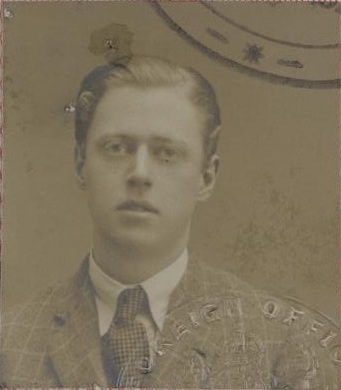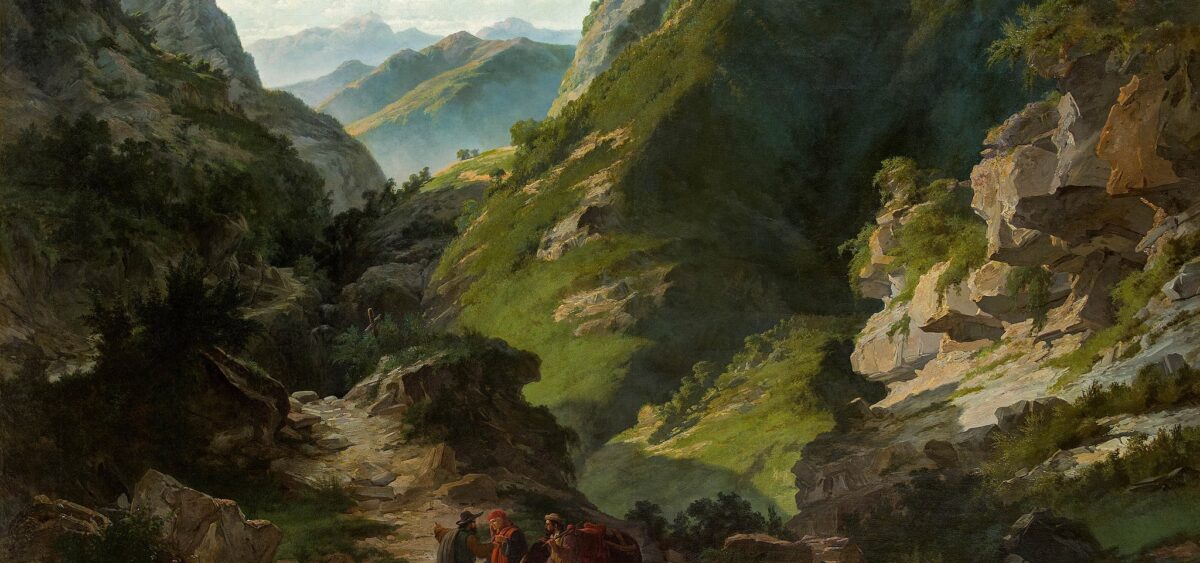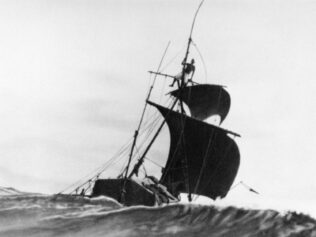
Educated adventurers craved action but also had a knack for observation. Enthusiastic about their own culture, they were eager to learn about others. As a result, British writer-wanderers created a unique subgenre of travel literature.
It was 1925 when the twenty-year-old Robert Byron, who had just graduated from Oxford, embarked on a journey with his two friends. Upon reaching Athens, they discovered that Robert’s namesake, Lord Byron—a hero in Greece’s struggle for independence—was still highly revered there. It was even said that if a relative of Lord Byron were to be found, they might take a prominent position in the new government, perhaps even becoming a ruler, albeit a puppet one at best. The young traveler, who not only boasted a great name (though he shared no kinship with the famous poet) but also had admirable self-confidence, seized the opportunity. He left his friends at the beach in Phalerum, crossed the street, and entered the nearby Ministry of Flight. Wearing a bathing suit, he met with Minister Kokkinopoulos, who was only slightly older than him. Although no job was arranged, the Greek politician, who had been educated in Scotland, promised Byron that they could talk more that evening at a cocktail party.
Although the Brits found the time to change into evening clothes, they also managed to get tipsy before arriving at the banquet. The minister was kind enough to notice them and keep their company, but the waiters seemed to ignore them. Annoyed by this, they rashly decided to break their glasses to draw attention. Minister Kokkinopoulos suddenly remembered that he had someone to attend to. “Thus are thrones won and lost,” Byron later recalled in his debut book Europe in the Looking-Glass. The scene feels like an ironic self-commentary on the buffoonery sometimes displayed by those Brits who assume their culture to be superior.
A record of travels across Germany, Italy, and Greece, Europe in the Looking-Glass has a broad tonal range, bringing together reviews of performances, erudite architectural descriptions, and reports of trivial entertainment. Everything is imbued with the spirit of youthful adventurousness, delight is intertwined with contrariness. The latter became Byron’s hallmark. Several years later in Moscow, a guide from the Soviet tour operator Intourist denied Shakespeare’s authorship of his work, arguing that it was impossible for a shopkeeper from Stratford-upon-Avon to have written such outstanding plays. Byron allegedly responded that they were exactly the kind of writing he would expect from a shopkeeper. He found it repulsive to subscribe to any widespread opinions. For example, he loathed Paris and did not care for any Western art after El Greco.

The Original Tourist
The car journey of the three English dandies echoed the tradition of the Grand Tour, which reaches back to the 17th century and thrived until the end of the 19th. An educational journey across Europe, it was reserved for members of the upper class. Over time, as interest in classical culture grew, it became increasingly popular to follow in the footsteps of ancient Europeans. Young men set off for Italy and Greece to complete their education, although the journey also had an equally important aspect of initiation. Accounts of the world’s wonders interspersed with the adolescent heroes’ adventures provided excellent literary material that was often published later as printed memoirs.
A pioneer in this field was Thomas Coryat, who in 1611 published Coryat’s Crudities: Hastily Gobled up in Five Moneths Travels, a work documenting his five-month trek through Europe. He later supplemented the account with letters reporting on an expedition from Jerusalem to India. His readers learned about the palaces of Venetian courtesans and polychoral concerts at the San Rocco church, as well as reading stories about William Tell and the Spanish Inquisition. He also familiarized his British compatriots with the use of the fork and umbrella, both of which he saw in Italy.
Despite graduating from Oxford’s Gloucester College, this son of a rural pastor was regarded by the elites as a rogue rather than a serious explorer. His blunt declaration that “of all the pleasures in the world Travel is the sweetest and most delightful” did not land well with Puritan moralists, who regarded travel follies as the first step to hell. Joseph Hall, the conservative Bishop of Norwich, known as the English Seneca, was criticizing young aristocrats at the time, writing that they brought shame on their homeland during their trips across the continent.
Coryat traveled on foot through Greece, Turkey, and Persia to India, and did so out of sheer curiosity at a time when people set out across the world mainly for commercial gain, imperial conquests, or religious crusades. Unfortunately on the subcontinent he contracted dysentery, which on the advice of East India Company merchants he tried to cure with sherry, eventually leading to his death. Even if it’s hard to imagine this 17th-century vagabond endorsing all-inclusive holidays, he can be safely considered an honorary member of the British club of eccentrics whose travel accounts popularized the idea of tourism.
One peculiar memento left by Coryat was a pair of shoes that he hung in the church in his native village of Odcombe. They remained there for one hundred and sixty years, and when they were lost, their image was immortalized on a stone slab. The fame of this exhibit is also celebrated in poems collected by the traveler, written by guest authors. Those traveling on foot, who are forced to spend a lot of time in their own company, establish a special relationship with their modest equipment, the most important pieces being the backpack and shoes.
A Curiosity About the World
Robert Byron was part of the London bohemia, leading a life of lavish excess that only members of the moneyed classes could afford. Racing vintage cars through the streets of the capital and attempting to set the Thames on fire with twenty gallons of petrol were only some of the pastimes in which the young writer indulged. Finally, however, curiosity pushed him to abandon the merry company of London and embark on further journeys. He recorded his travel experiences in the aforementioned Europe in the Looking-Glass, as well as in The Station, devoted to the Orthodox monasteries on Greece’s Mount Athos, First Russia, Then Tibet, and The Road to Oxiana, considered his best work but first published in 1937—a book on which generations of travel writers have been raised.
One such writer, Bruce Chatwin, wrote in the preface to the 1981 edition of The Road to Oxiana that it is a “sacred text, beyond criticism,” and confessed that he carried it with him on his four treks through Central Asia. Fascinated by its author, he collected the memories of his friends, who called him offensive, terribly teasing, and incredibly funny. These traits are confirmed on the pages of The Road to Oxiana, which records Byron’s travels through the Middle East, Persia, and Afghanistan, as he aims to uncover the Central Asian origins of Islamic architecture.
The history of Eastern art is just one of the many dimensions of this work. Chatwin marvels at the book’s “uncanny ability to gauge the morale of civilization from its architecture, and to treat ancient buildings and modern people as two facets of a continuing story.” The form of a travelog allowed Byron to weave into the story short dialogues with colorful characters he met along the way. These passages—sometimes truly hilarious, like the writer’s discussion with the Afghan Ambassador to Iran, during which the diplomat prophetically compares the latter country to a donkey dressed as a lion—reveal the socio-cultural background and display Byron’s political insight. Notably, he never succumbs to an orientalist and exoticized vision of Turkestan, discerning the behind-the-scenes games of China, Russia, and Afghanistan, all vying for influence in the region.
Describing his stay in Trieste, he portrays German Jews fleeing from Nazism to Palestine. Unlike many of his friends from the London elite, most of whom did not foresee the impending danger and were often fascinated by Hitler, Byron grasped well—already when writing The Road to Oxiana—what the consequences of the birth of fascism in Europe would be, and spoke loudly on this subject. There is no contradiction here—a mocker can be a sensitive humanist, while an art-loving aesthete can be a penetrating political prognosticator.
Byron finished writing his last book in Beijing, where he found himself traveling in the footsteps of aristocrat Desmond Parsons, an admirer of East Asian art whom Byron was in love with. Parsons did not reciprocate his feelings, but this did not prevent the writer from losing hope. In the end it was dashed once his beloved fell ill and returned to Britain. The publishing of The Road to Oxiana, which Byron completed despite his emotional breakdown, coincided with Parson’s death. Byron also died prematurely as a British agent onboard a ship torpedoed by a German U-Boot in 1941.
The Backpack from Mount Athos
Perhaps if eighteen-year-old Patrick Leigh Fermor had not met Robert Byron in one of London’s smoky clubs in 1933, he would never have become a traveler and writer. Byron’s description of Mount Athos from The Station inspired the young dreamer to visit the former Byzantine territory. This was also around the time that George Orwell’s Down and Out in Paris and London was published, which in turn inspired Fermor to undertake his trip with an almost empty wallet. He abandoned his studies the same year and embarked on his journey, thoroughly convinced that he must write a novel. At this time, Byron was already in Mashhad in Iran, gathering material for The Road to Oxiana. The younger, amateur adventurer only took a backpack from Athos, borrowed from one of Byron’s companions, and a copy of The Station. His route went across the Netherlands, then along the Rhine and Danube, the destination being Istanbul—or rather Constantinople, since Fermor was enamored with the vision of an everlasting Byzantium and felt history to be more real than the present.

This journey was no longer a Grand Tour. It brings to mind instead the tradition of wandering scholars and journeymen in medieval Europe (in Fermor’s passport the young man gave, rather loftily, his occupation as “student”). With a budget of one pound per week, he traveled mainly on foot, immersing himself in Gothic cities in Germany, Bavarian baroque, and the still very traditional Slavic countryside. He slept in barns but, thanks to letters of recommendation, was received in the castles of Mitteleuropa aristocrats, who were already slowly exiting the historical stage. Fermor described his travel experiences forty-four years later. Still, The Broken Road covers only the first part of the journey, which ends at a bridge on the Danube, just before the Hungarian border. His dense style draws on Byron’s compositional technique of mixing themes and tones, but is smoother and richer.
Incidentally, Fermor’s erudite displays would be indigestible if they didn’t lead to brilliant analyses and comparisons, such as the one juxtaposing the architecture of southern German towns with the clothes worn by a Landsknecht: “medieval solidity adorned with a jungle of inorganic Renaissance detail.” In his work—and that of other authors in this type of travel literature—it is important to contextualize the described phenomena in a wider temporal perspective. The rich prose of an already mature writer is balanced with a solid rendering of the youthful insatiability of yesteryear. The traveler, dizzy with a heady stream of sensations, “grudged every second of sleep.”
After Fermor reached his first destination, the story gained momentum. The writer did not return to England, but set out to Athens, where his militaristic fantasies were realized during the Greek Civil War. He participated in the charge of the Monarchist cavalry against the Republicans. In the Greek capital he met the Romanian princess Balasha Cantacuzene, with whom he later lived for two years in Moldova. While on Crete with Greek partisans during World War II, he captured a German commander and smuggled him to the other side of the island while disguised as a shepherd.
After the war, Fermor spent most of his time in Greece, writing two books about the country: Mani: Travels in the Southern Peloponnese and Roumeli: Travels in Northern Greece. The former records his excursions through the most remote and isolated part of the peninsula. Although the journey itself is described so evocatively that one immediately feels like traveling to the Peloponnese, it only constitutes a pretext to discuss Greek history and culture. Even though Fermor touches on traces of ancient times, he was more fascinated with the local tradition, hitherto overlooked in English literature, with its cult of miraculous icons and rich demonology. The Peloponnesian journey with his future wife Jane never really ended, because years later they built a house on the peninsula, in the town of Kardamyli. Situated on a seaside cliff at the feet of the Taygetus, the sandstone villa was frequented by the Greek poet and Nobel laureate Giorgos Seferis; Colin Thubron, who was also inspired by Robert Byron and wrote about Central Asia; and the aforementioned Bruce Chatwin, who liked to write while staying at his friends’ (just as his host did in the pre-Kardamyli days).
In the end, Fermor offered the younger writer his eternal hospitality by placing his ashes in a small Byzantine chapel near his house. Stricken with a virus, Chatwin was nevertheless able to gift his backpack, with which he traveled through Patagonia and Australia, to his friend, an avid hiker: Werner Herzog.
Translated from the Polish by Grzegorz Czemiel








